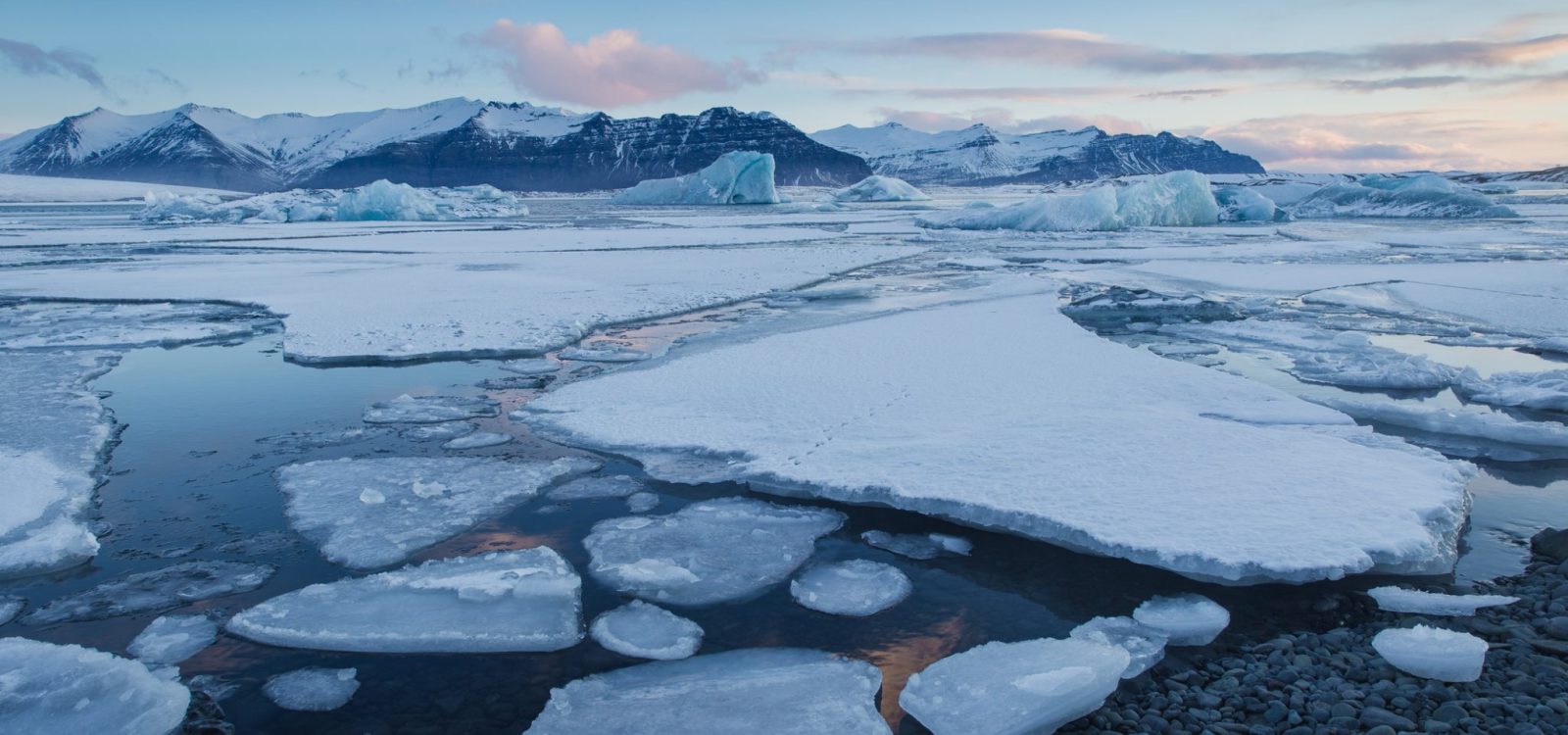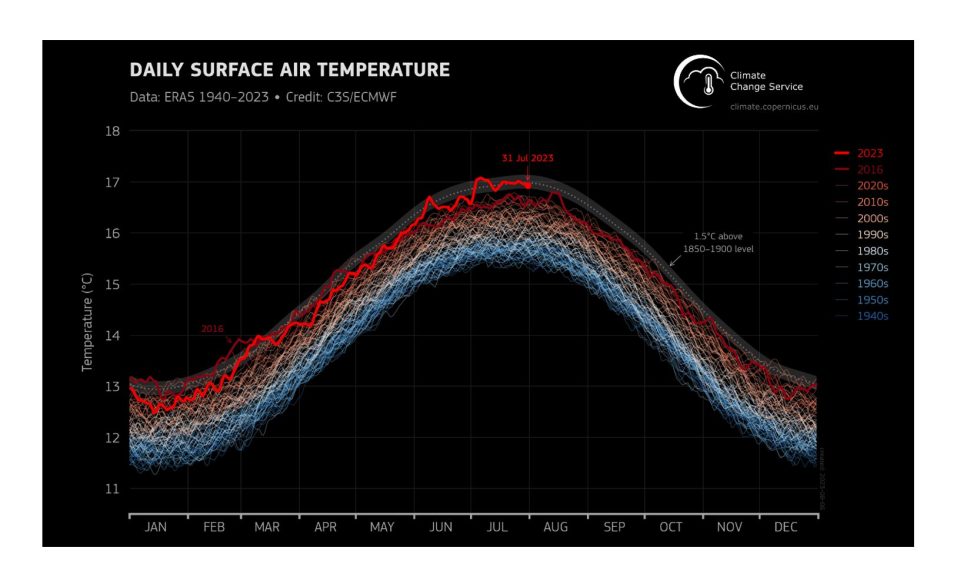
The Hottest Month on Record
July 2023 was the hottest month on record globally, with global mean surface air temperature records broken by a significant margin[1].
Global land and ocean climate records tumbled, providing further evidence that climate change is hitting the planet faster than scientists originally thought. In this article, Chair of the Institute’s Climate and Sustainability Working Group, Ramona Meyricke chats to Tom Mortlock, APAC Climate Risk Advisory Lead at Aon, about the drivers of recent climate events and what these events might mean for the upcoming Australian summer and longer-term climate adaptation efforts.
Ramona: Can you explain how warming of the oceans, sea surface temperatures and changes in atmospheric circulation contributed to the record-breaking heat in July?
Tom: While we often focus our attention on the rate of warming in the atmosphere, more than 90% of the global heat content since the 1970s has been absorbed by the oceans.
Warmer oceans have far-reaching impacts beyond sea level rise. For example, warmer oceans create more fuel for cyclone formation; increased frequency of marine heatwaves, which can provide a moisture source for storms, and lead to coral bleaching events. Warmer oceans also lead to changes to ocean circulation patterns, which in turn impact weather patterns over land; and changes to wind and wave patterns impacting our coastlines.
The ocean covers more than 70% of the planet and, to a certain extent, is the long-term driver of climate change impacts we feel on land.
Figure: ERA5 data from the Copernicus Climate Change Service (C3S*) show that July 2023 was the hottest month on record

Ramona: The term “heat domes” is currently in the media. What are heat domes and will we experience more of them as warming progresses?
Tom: “Heat dome” describes a warm air, high-pressure system that gets stuck in one place over a long period, preventing clouds from entering which would help cool temperatures.
They often get trapped in place when we have a very curvy jet stream. The jet stream is a high-altitude band of fast-moving wind that occurs in the mid-latitudes of each hemisphere. When it’s running fast, it runs like a river and it’s fairly straight. But when it’s running slow, it meanders all over the place and this can trap high-pressure cells, leading to heat domes.
The jet stream is held in place by the temperature differential between the Arctic and sub-Arctic regions. Now, the Arctic is warming four times faster than the global average; some research suggests this may destabilize the jet stream leading to more periods of these cut-off weather systems like heat domes. For example, in 2021, the “Texas freeze” and the European and Chinese floods were all related to the meandering of the jet stream, as was the US heatwave this year.
Ramona: During July, global warming temperatures also temporarily exceeded 1.5°C threshold – a limit set in the Paris Agreement. Is this a significant milestone?
Tom: When we talk about 1.5 degrees of warming, it’s important to define what we mean. The target we have set ourselves is to not exceed a 1.5 degree increase in the 30-year global average of combined air temperature over land and water temperature at the ocean surface, compared to the 1850 – 1900 pre-industrial baseline. We have already exceeded the 1.5-degree threshold in certain parts of the world in recent years – but this is not the same thing as the 1.5-degree target set in the Paris Agreement.
It is now highly likely that we will exceed this threshold – as a global average – within the coming decade. This threshold is important. Unlike carbon emissions targets where we can allow ourselves to “overshoot” before hoping to go net negative thereafter, the temperature threshold is linked to avoiding some of the major tipping points in the earth’s climate system. Ice sheet collapse, mass coral die-off, overland glacier melts and fundamental shifts in global ocean circulation are all thought to have a temperature tipping point, and exceeding this threshold is essentially the point of no return for these systems.
We also cannot forget the impact of warming on the frequency of extreme weather events, particularly heatwaves. Extreme heat events are expected to occur about four times more frequently by the end of the century compared to present day – and that’s if we limit warming to the 1.5-degree threshold. An important point here is that a small shift in the mean temperature results in a much larger shift in the tails of the distribution (the extreme weather events). 1.5 degrees may not sound like much, but the impacts are amplified at the tail.
Ramona: The Australian summer is fast approaching, what are the current expectations? Can we expect to see more records broken in Australia?
Tom: We’ve just come out of a very wet period of weather, particularly in Eastern Australia, which was driven by a rare triple-dip La Niña (three back-to-back La Niña events – the first in 22 years). Now that La Niña is behind us, it looks like El Niño will be the feature of the 2023/24 summer – meaning we can expect conditions to be warmer and drier than average – and the potential for more record-breaking temperatures.
We haven’t experienced an El Niño in Australia since 2016. Contrary to popular belief, the 2019/20 Black Summer was not an El Niño, but rather a strong positive Indian Ocean Dipole. After three years of wet conditions, there has been significant fuel growth across the landscape, which leads to bushfire concerns, however it is unlikely we’ll see a repeat event on the scale of the Black Summer bushfires this summer.
There are a lot of ingredients that go into making a catastrophic bushfire. In 2019/20, a wildcard known as “Sudden Stratospheric Warming” (SSW) turbo-charged the drying out of the landscape in spring which combined with the positive Indian Ocean Dipole, resulted in disaster. SSW events are rare, particularly in the Southern Hemisphere, and most climate models suggest they will become rarer with continued warming.
Ramona: Let’s end on a positive note. What keeps you hopeful that we can avoid catastrophic climate change?
Tom: I think there are several things to remain positive about. We’ve seen a monumental shift in the way climate change is viewed over the past several years. Climate change has progressed from being a “horizon” issue for most – something that is psychologically distant and not a present-day concern – to a here-and-now issue.
Particularly in the financial services sector, there is a widespread recognition that – alongside global carbon mitigation efforts – we need to build resilience to the climate impacts that are already affecting housing and insurance affordability. It is no longer just about risk transfer, but more about actively improving the risk profile of Australia’s built environment through resilience measures.
Second, it’s not the first time the global community has come together to solve a multi-generational, global environmental issue. Back in the 1980s there was a coordinated global effort to eliminate chlorofluorocarbons (CFCs) as they were creating a hole in the ozone layer.
Today CFCs are no longer a problem, and the ozone hole is all but repaired. It’s true that CFCs are not as core to the global economy as carbon, but there is already a huge amount of progress that has been made over the past decade, and the rate of progress is increasing.
References
CPD: Actuaries Institute Members can claim two CPD points for every hour of reading articles on Actuaries Digital.





